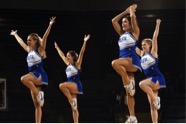If images of blonde girls shaking their pom-poms and yelling at football games pop into your mind when you hear the word “cheerleading,” then you might just want to sit down: The first cheerleaders were men.
When cheerleading came into existence in the United States in 1898, it was an activity reserved exclusively for white, well-educated male students. Only the most enthusiastic and charismatic boys were elected by their classmates to be on the team. It was an honorable position and opened up doors for several young men such as future presidents Dwight D. Eisenhower, Ronald Reagan, and George W. Bush.
During the 1930s, women were finally allowed to join the cheerleading team. When men had to leave school to fight in World War II, girls took over their positions, adding new elements such as dancing to the performance. As a result, cheerleading became a female-dominated activity, and cheerleaders began to appear in ads in the 1950s. Whether it was Lucky Strikes, Milky Way, Dr. Pepper or Texaco Anti-Freeze, cheerleaders were used to advertise all sorts of products. Many ads depicted girls in skirts and sweaters, holding megaphones or pom-poms and flashing big bright smiles. The icon of the cheerleader appealed to men, women, and teenagers alike. Even the German Coke Zero TV spot from 2013 used the cheerleader icon:
In comparison to many other extra-curricular activities and professions, cheerleading happens to be one fraught with a multitude of negative stereotypes. Whereas women cheerleaders are usually portrayed as dumb sex objects, the men are often considered homosexual. In fact, male cheerleaders struggle with their gender roles and are under constant pressure to prove their masculinity as well as their heterosexuality to others. Additionally, cheerleading is still not accepted as an official sport. However, cheerleading – especially All-Star cheerleading – requires as much athletic strength, discipline, acrobatic skills, and dedication as competitive sports do. The National High School Cheerleading Championship (NHSCC) is the most prestigious of the competitions and is aired on ESPN. To make matters worse, many contemporary movies such as American Beauty, Cheerleader Camp, and even horror movies like All Cheerleaders Die perpetuate these one-sided images.
 So what can you do to make a difference? It’s simple. The next time you hear the term “cheerleading,” think beyond the stereotypes of the blonde, sexually promiscuous girl and homosexual boy, and see them for who they really are: hard-working athletes.
So what can you do to make a difference? It’s simple. The next time you hear the term “cheerleading,” think beyond the stereotypes of the blonde, sexually promiscuous girl and homosexual boy, and see them for who they really are: hard-working athletes.
Saskia is a B.A. student of American Studies and Media at Humboldt University Berlin. In 2009–2010, she spent an exchange year in Sheboygan, Wisconsin. She herself does not practice cheerleading. She hopes to pursue a Master’s degree in American Studies at Humboldt University as well.
Justine, a student of American and Cultural Studies, is currently writing her B.A. thesis. She is a cheerleader and attended the European Cheerleading Championship in Manchester. She has spent a high school year in Oklahoma and will leave Germany in the summer to work as a fitness instructor somewhere in Europe. She is considering pursuing a Master’s degree in Journalism.
17,918 Total Views, 4 Views Today






